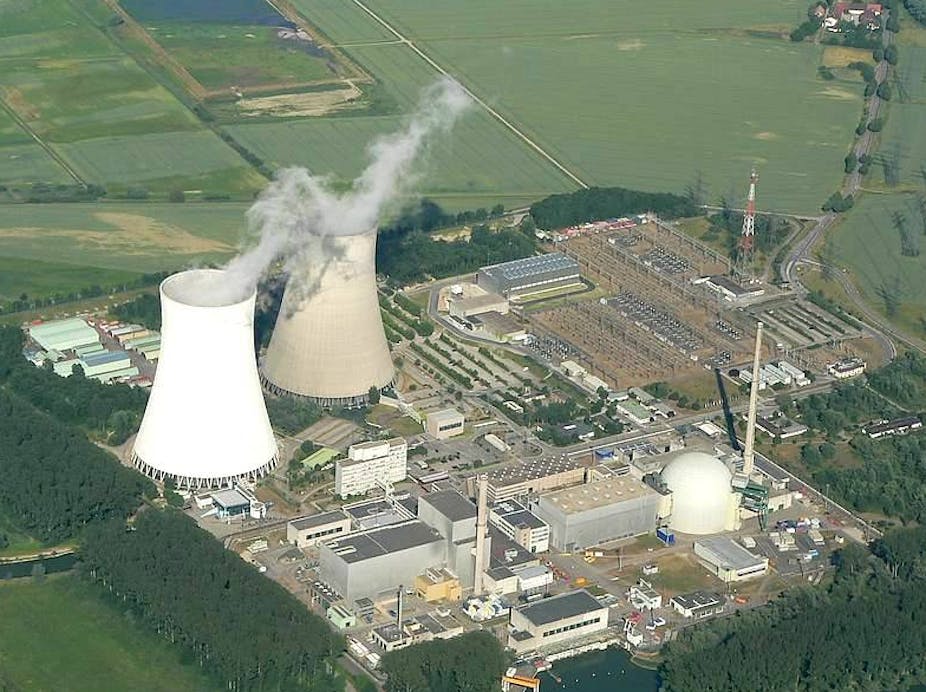Nuclear power is back on Australia’s radar. In its recent issues paper released as a preface to September’s Energy White Paper, the Abbott government reopened the debate thus:
With environmental considerations constraining the further development of hydro-electric sources, nuclear technologies continue to present an option for future reliable energy that can be readily dispatched into the market.
This sentence appears in a passage dealing with the “move to low-emissions energy”, and although nuclear is not explicitly described as a low-emission option, it certainly looks as if the government is prepared to consider embracing nuclear power as part of an alleged move away from fossil fuels.
Is nuclear energy really low-emission?
Unfortunately, the notion that nuclear energy is a low-emission technology doesn’t really stack up when the whole nuclear fuel life cycle is considered. In reality, the only CO2-free link in the chain is the reactor’s operation. All of the other steps – mining, milling, fuel fabrication, enrichment, reactor construction, decommissioning and waste management – use fossil fuels and hence emit carbon dioxide.
Several analyses by researchers who are independent of the nuclear industry have found that total CO2 emissions depend sensitively on the grade of uranium ore mined and milled. The lower the grade, the more fossil fuels are used, and so the higher the resulting emissions.
In one such study, the nuclear physicist (and nuclear energy advocate) Manfred Lenzen found that CO2 emissions from the nuclear fuel cycle increase from 80 grams per kilowatt-hour (g/kWh) where uranium ore is high-grade at 0.15%, to 131 g/kWh where the ore grade declines to low-grade at 0.01%.
Other experts, such as nuclear energy critics Jan Willem Storm van Leeuwen and Philip Smith, using assumptions less favourable to nuclear energy, have reported an increase in emissions from 117 g/kWh for high-grade ore to 437 g/kWh for low-grade ore.
For comparison, the life-cycle emissions from wind power are 10–20 g/kWh, depending upon location, and from gas-fired power stations 500–600 g/kWh. So depending on your choice of analysis, nuclear power can be viewed as almost as emissions-intensive as gas.
Making the grade
The quantity of known global uranium reserves with ore grades richer than the critical level of 0.01% is very limited. With the 2013 contribution by nuclear energy of about 10% of the world’s electricity generation, the high-grade reserves would at best last several decades. It doesn’t make sense to invest vast amounts of money in a technology that will emit more and more CO2 over time.
Are there alternative future pathways for obtaining nuclear fuel that could have lower emissions? Although there are vast quantities of uranium oxide in the Earth’s crust, almost all of such reserves exist at very low concentrations, typically 0.0004%. At this grade, 1000 tonnes of ore would have to be mined to get 4 kilograms of uranium in the form of yellowcake.
In this case the energy needed to extract uranium would be orders of magnitude greater than the energy output of the nuclear power station. There is a limit to how much the uranium industry can be expected to chase diminishing returns. For instance, seawater contains uranium, but at a concentration of about 0.0000002%, meaning that a million tonnes of seawater would have to be processed to extract just 2 kilograms of uranium.
The technology trap
Could new types of nuclear power station solve the problem? “Fast breeder reactors” produce more nuclear fuel than they use and so would theoretically have much lower life-cycle CO2 emissions than existing “burner” reactors. But in practice breeders are even more complex, dangerous and expensive than burners. As a result they have been stuck at the demonstration stage for decades and even some nuclear proponents admit that breeders are unlikely to be commercialized for at least another two decades, if ever.
The government’s issues paper mentions the possibility of nuclear reactors based on the thorium fuel cycle, but these are also more complex than uranium-based nuclear energy and there are no commercial systems operating as yet.
Advocates of another possible option, nuclear fusion on Earth, recognize that it unlikely to become a commercial reality for at least three decades, if ever.
To sum up, based on existing commercial technology, nuclear energy is not a solution to the global climate crisis, because it will soon become too emissions-intensive. It is also not a short-term solution, because it is a very slow technology to plan and construct. It is dangerous and very expensive.
So why bother? There is already a better alternative to fossil fuels: the efficient use of renewable energy.
* This article is an edited extract from Sustainable Energy Solutions for Climate Change, published in Australia and New Zealand by UNSW Press in December 2013 and due to be published overseas by Earthscan in April 2014. References are included in the book.

